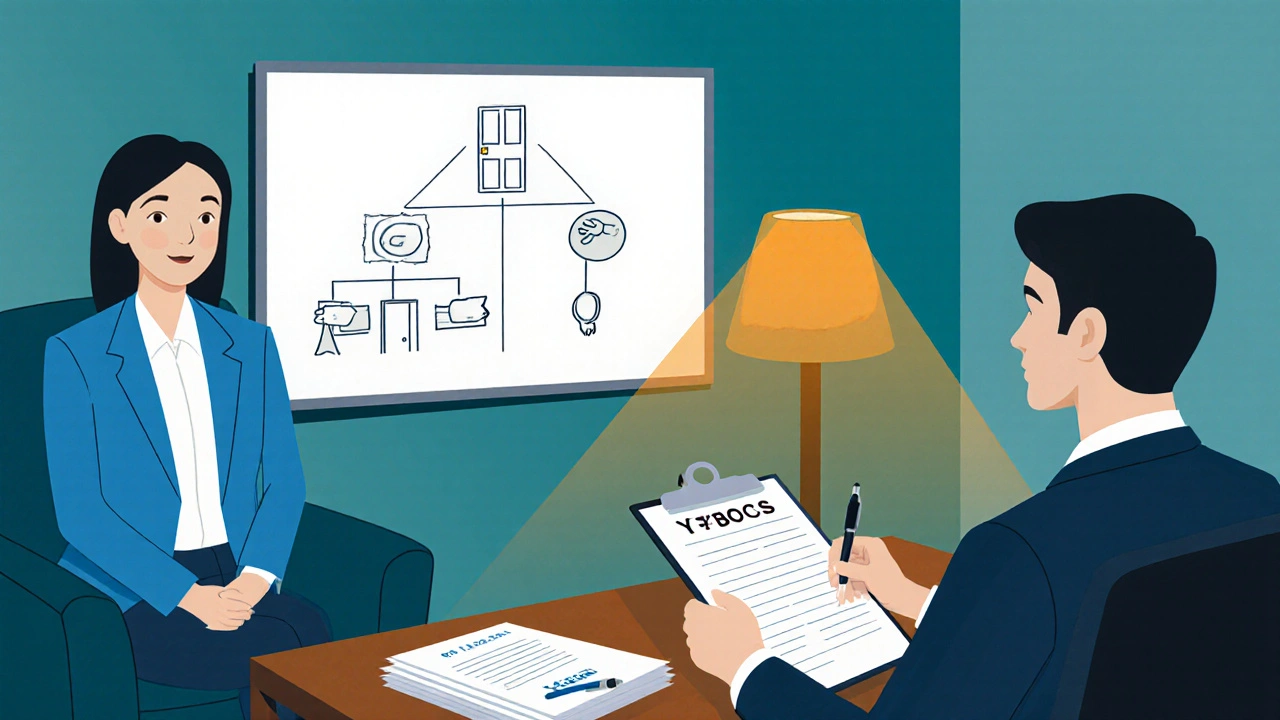OCD Therapist Match Calculator
Use this calculator to systematically evaluate potential OCD therapists based on key criteria. Rate each factor from 1-5 stars, then click "Calculate Score" to see your overall match rating.
Clinical Fit (40%)
Assesses ERP expertise, OCD specialization, and years of experience.
Logistical Fit (30%)
Evaluates location, telehealth options, insurance coverage, and costs.
Personal Fit (30%)
Considers communication style, empathy, and compatibility.
Your Match Rating
0
Overall Score
-
Match Rating
Finding the right professional to help manage obsessive‑compulsive disorder can feel like searching for a needle in a haystack. The stakes are high-an effective therapist can dramatically reduce intrusive thoughts and compulsive rituals, while a mismatch can waste months of time and money. Below is a step‑by‑step roadmap that lets you zero in on a qualified OCD therapist who matches your needs, preferences, and budget.
Key Takeaways
- Look for clinicians trained specifically in Cognitive Behavioral Therapy (CBT) and Exposure and Response Prevention (ERP), the two evidence‑based cornerstones for OCD.
- Prefer therapists who list OCD as a specialty and have at least two years of direct experience treating the disorder.
- Check practical details early: licensing, insurance acceptance, telehealth options, and session fees.
- Prepare a short list of questions for the initial consultation to gauge fit, style, and treatment plan.
- If anything feels off-vague explanations, lack of ERP focus, or pressure to take medication without proper evaluation-walk away.
1. Know What Effective OCD Therapy Looks Like
Obsessive‑compulsive disorder is a brain‑based anxiety condition characterized by unwanted, repetitive thoughts (obsessions) and ritualistic behaviors (compulsions) performed to neutralize anxiety. The gold‑standard treatment is a blend of two therapeutic approaches:
- Cognitive Behavioral Therapy (a structured, time‑limited therapy that helps patients identify and challenge distorted thinking patterns).
- Exposure and Response Prevention (a behavioral technique that gradually exposes patients to feared situations while preventing the usual compulsive response), usually delivered as a sub‑type of CBT.
Any therapist claiming to treat OCD should explicitly reference both CBT and ERP. If a clinician focuses only on talk therapy without exposure work, the likelihood of meaningful symptom reduction drops dramatically.

2. Verify Professional Credentials
Credentials tell you how much formal training a therapist has received. The most common qualifications for OCD work in the UK and many other countries include:
| Title | Core Training | Prescribing Rights | Typical ERP Experience |
|---|---|---|---|
| Licensed Clinical Psychologist | Doctorate (PhD or DClinPsych) + CBT/ERP certification | None | High - often specialist |
| Psychiatrist | Medical degree + CBT/ERP training (optional) | Yes - can prescribe medication | Variable - many rely on psychologists for ERP |
| Licensed Professional Counselor (LPC) / Chartered Counsellor | Master's level + CBT/ERP coursework | None | Moderate - depends on supervision |
| Clinical Social Worker (CSW) | Master of Social Work + CBT/ERP training | None | Moderate - often part of multidisciplinary teams |
When you locate a potential therapist, verify their registration with the relevant professional body (e.g., Health and Care Professions Council in the UK, American Psychological Association in the US). This step protects you from unqualified providers.
3. Gauge Direct OCD Experience
Experience matters more than the generic title. A therapist who has handled 50+ OCD cases is more likely to have refined ERP protocols than someone who lists “anxiety” as their only specialty. Ask for concrete numbers:
- How many OCD patients have they treated in the past 12 months?
- Do they specialize in any OCD sub‑types (e.g., contamination, checking, symmetry)?
- Can they provide a brief case example (maintaining confidentiality) that demonstrates successful ERP?
Clinicians who can articulate a clear treatment roadmap-assessment, hierarchy building, exposure sessions, and relapse prevention-show that they have a systematic method rather than an ad‑hoc approach.
4. Practical Factors: Location, Telehealth, and Insurance
Even the best therapist is useless if you can’t meet them regularly. Here are the logistical pieces to sort out early:
- Physical Location: Are they within a reasonable commute? Consider traffic, public transport, and parking.
- Teletherapy: Many OCD specialists now offer video sessions. Look for platforms that are secure (e.g., Zoom for Healthcare, Microsoft Teams) and check whether the therapist has a dedicated telehealth license for your region.
- Insurance Compatibility: In the UK, many therapists operate on a private‑pay basis, but some NHS trusts have referral pathways for CBT/ERP. In the US, verify that the therapist is in‑network with your health plan to avoid surprise bills.
- Cost per Session: Private rates range from £80‑£150 in the UK and $100‑$200 in the US. Some clinicians offer sliding‑scale fees based on income.
Write down these practical details on a comparison sheet so you can see which providers tick the most boxes.
5. The Initial Consultation: Your 10‑Minute Interview Checklist
Most therapists offer a free 15‑minute phone call or a low‑cost first session. Use this time to ask targeted questions that reveal both competence and therapeutic style.
- “What is your specific training in ERP for OCD?” - Look for mention of recognized courses (e.g., International OCD Foundation, Beck Institute).
- “Can you walk me through a typical ERP session?” - You should hear about hierarchy creation, exposure exercises, and response‑prevention strategies.
- “How do you measure progress?” - Expect references to standardized scales such as the Yale‑Brown Obsessive‑Compulsive Scale (Y‑BOCS).
- “What is your stance on medication?” - A collaborative therapist will discuss medication as an adjunct, not a replacement, and suggest a psychiatrist if needed.
- “Do you offer homework assignments and how often do we review them?” - ERP relies heavily on between‑session practice.
Take notes. If the therapist seems vague, evasive, or overly sales‑y, keep looking.

6. Red Flags to Avoid
Even seasoned patients can fall for persuasive yet ineffective providers. Watch for these warning signs:
- Generalist language: “I help with anxiety” without any mention of ERP.
- Lack of outcome measurements: No use of Y‑BOCS or similar tools.
- Pressure to start medication before any psychotherapy trial.
- Unwillingness to share credentials or provide proof of registration.
- Frequent cancellations or a “waitlist” that never resolves.
Trust your gut. If you feel rushed or unheard, it’s okay to end the conversation and move on.
7. Making the Decision and Setting Up Your First Real Session
After you’ve gathered data, compare providers side‑by‑side. Give each therapist a weighted score based on three categories:
- Clinical Fit (40%): ERP expertise, OCD specialization, years of experience.
- Logistical Fit (30%): Location/telehealth, insurance, cost.
- Personal Fit (30%): Communication style, empathy, willingness to answer questions.
The highest scorer is likely your best match. Book the first paid session, ask for a treatment plan in writing, and schedule a follow‑up after 4‑6 weeks to assess early progress.
8. What to Expect in the First Few Weeks
Early sessions will involve a thorough assessment, including a clinical interview and completion of the Y‑BOCS questionnaire. You’ll then co‑create an exposure hierarchy-a ranked list of feared situations. The therapist will guide you through brief, controlled exposures each week while you resist the compulsive response. Homework will be a crucial part of the process; expect 30‑60 minutes of daily practice.
Noticeable improvement often appears after 8‑12 weeks of consistent ERP, though individual timelines vary. If you feel stuck after 3 months, discuss adjustments with your therapist-perhaps adding mindfulness techniques or reviewing the hierarchy.
Frequently Asked Questions
How long does OCD therapy usually last?
A typical ERP program runs for 12‑20 weekly sessions, but many people continue with monthly booster appointments for maintenance.
Can I do ERP on my own without a therapist?
Self‑directed ERP is possible if you have a solid understanding of the hierarchy and response‑prevention principles. However, most clinicians recommend at least an initial professional assessment to ensure safety and effectiveness.
Do I need a psychiatrist if I find an OCD therapist?
A psychiatrist is useful if medication (e.g., SSRIs) is part of the treatment plan. Many successful cases combine ERP with medication, but the therapist can coordinate care with a prescribing doctor as needed.
Is teletherapy as effective as face‑to‑face ERP?
Research up to 2024 shows comparable outcomes when the therapist follows a structured ERP protocol and uses secure video platforms. Consistency and a good therapeutic alliance matter more than the medium.
What if I can’t afford private therapy?
Check local NHS or community mental health services for CBT/ERP groups. Some charities, like the International OCD Foundation, offer low‑cost therapist directories and sliding‑scale options.
Choosing the right therapist is a blend of research, practical checks, and intuition. By following the steps above, you’ll climb out of the endless search and step into a treatment plan that actually works.


Soumen Bhowmic
October 10, 2025 AT 01:31Wow this guide really breaks down the whole OCD therapist hunt into something manageable. I love how it emphasizes both the clinical credentials and the practical logistics, because half the battle is just getting to the appointment on time. The weighted scoring system feels like a cheat‑sheet for people who get lost in the sea of qualifications. Also, the checklist for the initial consultation is spot on – asking about ERP training and outcome measures saves a lot of guesswork. I’ve personally used a similar hierarchy when comparing therapists and it cut my decision time in half. Overall, this is a solid roadmap that anyone dealing with OCD should bookmark.
Jenna Michel
October 16, 2025 AT 18:38Great post! The integration of CBT and ERP as the gold‑standard is absolutely crucial-exposure without prevention is just avoidance, and the reverse lacks the therapeutic potency. Your emphasis on licensing bodies, such as the HCPCA in the UK or APA in the US, anchors the search in regulatory legitimacy. I also appreciate the explicit mention of telehealth security protocols (HIPAA‑compliant Zoom, Teams, etc.)-privacy is non‑negotiable. The red‑flag list is a lifesaver: vague “anxiety focus” and pressure to medicate are classic pitfalls. Combining clinical fit (40%) with logistical and personal factors mirrors the multidimensional decision‑making models we see in health economics. Kudos for the thoroughness!
Abby Richards
October 23, 2025 AT 11:44Thanks for the detailed guide! 👍 It’s super helpful to see the exact questions to ask during that 15‑minute intro call. I especially liked the tip about asking for a brief case example while keeping confidentiality-great way to gauge real‑world experience. The mention of the Y‑BOCS as a progress metric is spot on; I’ve seen it make a big difference in tracking improvements. 😊 Keep up the good work, this will definitely help a lot of folks!
Rajesh Kumar Batham
October 30, 2025 AT 04:51Totally agree, the checklist makes the whole process less intimidating. 👍
Bill Gallagher
November 5, 2025 AT 21:58Excellent synthesis!; The layered weighting (40% clinical, 30% logistical, 30% personal) mirrors evidence‑based decision frameworks; it ensures that you don’t over‑value convenience at the expense of therapeutic efficacy; Moreover, the explicit call for ERP expertise is essential because, as the literature shows, ERP is the most empirically supported intervention for OCD; By requiring clinicians to cite specific training (e.g., International OCD Foundation courses), you create a filter that screens out generic anxiety therapists; The inclusion of insurance compatibility early in the process reduces financial surprise; I also love the practical tip about sliding‑scale fees, which democratizes access; Finally, the emphasis on measuring outcomes with tools like Y‑BOCS provides an objective anchor for progress evaluation; Well done!
Rajashree Varma
November 12, 2025 AT 15:04Choosing the right therapist can feel overwhelming but patience and systematic evaluation create clarity. First, verify that the professional is registered with a recognized body; this protects you from unqualified practice. Second, ensure the clinician lists CBT and ERP as core treatment modalities; without both, success rates drop sharply. Third, inquire about the number of OCD cases handled annually; a higher volume often signals refined expertise. Fourth, ask for a concrete treatment plan that outlines assessment, hierarchy building, exposure sessions, and relapse prevention. Fifth, confirm telehealth security standards to safeguard confidentiality. Sixth, compare session costs against your budget and explore sliding‑scale options if needed. Seventh, evaluate the therapist’s communication style; feeling heard is a predictor of adherence. Eighth, assess empathy by noting whether the therapist validates your experience without judgment. Ninth, check that the therapist is willing to answer all questions thoroughly, fostering trust. Tenth, look for outcome tracking tools such as the Y‑BOCS to measure progress objectively. Eleventh, consider location and commute times to maintain consistency in appointments. Twelfth, verify insurance compatibility to avoid unexpected bills. Thirteenth, reflect on your gut feeling after the initial consultation; intuition matters. Fourteenth, create a side‑by‑side comparison chart with weighted scores to visualize the best match. Fifteenth, schedule a trial session and reassess after four weeks; early indicators guide long‑term commitment. By following these steps you transform a daunting search into a structured, evidence‑based journey toward recovery.
Anshuman Pandey
November 19, 2025 AT 08:11Building on the detailed framework, it’s worth noting that the therapist’s philosophy toward medication can shape treatment dynamics; collaborative approaches that view medication as an adjunct rather than a crutch often yield better outcomes; also, transparency about session structure helps set realistic expectations; finally, a clear hierarchy with graded exposures empowers the client to engage actively in therapy.
Thomas Malloy
November 26, 2025 AT 01:18Short and sweet: this is exactly the checklist I needed.
Sushma Gowda
December 2, 2025 AT 18:24I love the balanced tone of this guide-it’s both professional and caring. The step‑by‑step sections make it easy to follow, especially for someone new to therapy hunting. Highlighting the importance of asking about ERP training really stood out to me; it’s a non‑negotiable for OCD work. Also, the practical tip about writing down logistical details is golden; I’ve missed appointments before because I didn’t check insurance coverage early. Overall, this post feels like a supportive coach walking you through a maze.
Angie Wallace
December 9, 2025 AT 11:31Exactly, the practical tip about jotting down logistics is super helpful.